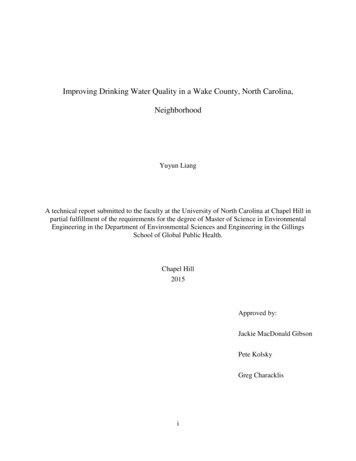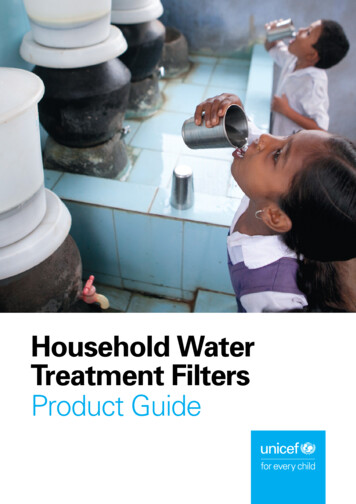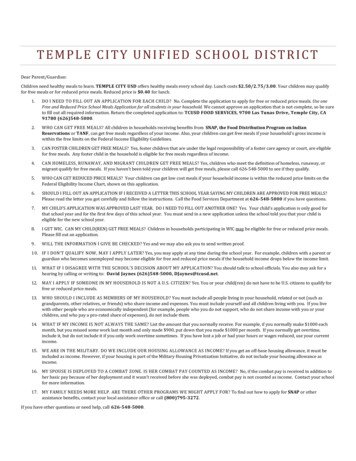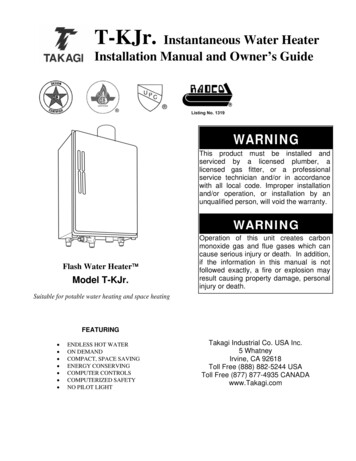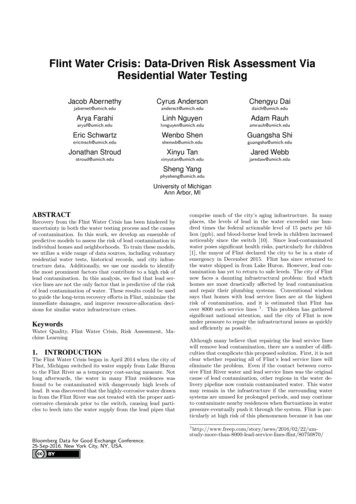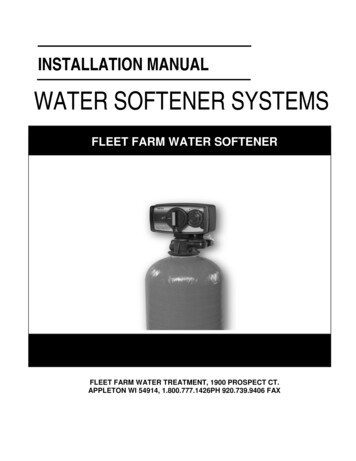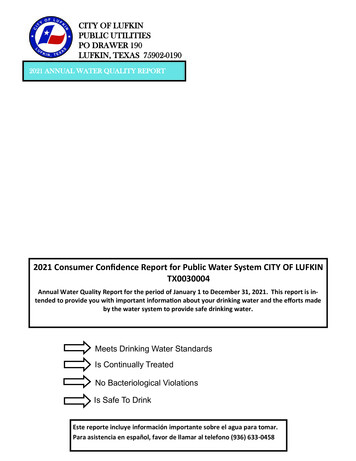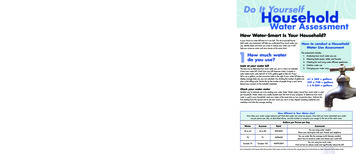
Transcription
Do It YourselfHousehold Water AssessmentHouseholdWater AssessmentWorksheet1. How much water do you use?Table 1a. Water consumption or use from your water bill gallons CCFLm3 (circle one)m3 x 264 gallonsCCF x 748 gallonsL x 0.264 gallonsb. Convert to gallons (see Table 1) .How Water-Smart Is Your Household?c days in billing cycleIs your house as water-efficient as it can be? This do-it-yourself household water use assessment will help you understand how much water youuse, identify leaks and show you ways to reduce your water use. It willhelp you conserve water and save money at the same time!d. Household use gallons (b.) days in billing cycle (c.)How Efficient Is Your Water Use?e. number of people living in your homeGallons per Person per Dayf. ANSWER: Divide household usage (d.) by number of people living inyour home (e.)Compare this number with the chart2. Detecting Leaks: Check forand fix any leaksa. Pipesyesno (circle one)b. Toiletsyesno (circle one)c. Faucetsyesno (circle one)WinterSummerRank50 to 6565 to 80EFFICIENT7091AVERAGEExceeds 70Exceeds 100INEFFICIENT1The assessment includes:1. Analyzing how much water you use2. Detecting leaks (pipes, toilets and faucets)3. Checking for and using water-efficient appliances4. Outdoor water useLook at your water bill5. Changing your water waysThe best way to determine how much water you use in a day is to calculateit from your water bill. Check how your bill measures water; it maybe incubic meters (m3), cubic feet (CF or CCF), gallons (gal) or liters (L). If yourbill is not in gallons, use the conversion table to the right. If your water bill does notdisplay average daily use, you can calculate it by dividing the number of gallons bym3 x 264 gallonsdays in the billing cycle. Divide this by the number of people living in your home.CCF x 748 gallonsRecord your answers on the included worksheet.3. Conserving Watera. Faucet and showerhead efficiencyFaucet 1How much waterdo you use?How to conduct a HouseholdWater Use AssessmentL x 0.264 gallonsFaucet 2Faucet 3Faucet 4Faucet 5Showerhead 1Check your water meterShowerhead 2Another way to estimate use is by reading your water meter. Water meters record how much water is usedper household. Water meters are usually located near the front of your property. To determine how muchwater is used in your household, read your meter at the same time on two consecutive days. Subtract thefirst reading from the second one to see how much you use in a day. Repeat including weekends andweekdays and take the average reading.Cups of Water in Bucket/BagX 0.0625 # of Gallons# of Gallons multiplyby 12 gallons per minuteb. Toilet 1 – Does the toilet have a stamp on the back (behind the seat) with 1.6 gpf (gallons per flush) on it?cups of water in toilet tank x 0.0625 # of gallons per flushToilet 2 – Does the toilet have a stamp on the back (behind the seat) with 1.6 gpf on it?cups of water in toilet tank x 0.0625 # of gallons per flushHow Efficient Is Your Water Use?How does your water usage measure up? Note that water use varies by season. Now that you have calculated your wateruse per person per day, as described above, use that number to compare your usage to the rest of the metro area.Toilet 3 – Does the toilet have a stamp on the back (behind the seat) with 1.6 gpf on it?cups of water in toilet tank x 0.0625 # of gallons per flushGallons per Person per Dayc. Other AppliancesDoes your washer machine allow you to change the water level for smaller loads? yesDoes your dishwasher allow you to change the amount of water used per cycle? yesd. Outdoor Water Use1. Check for outdoor hose or spigot leaks.2. If you have an automatic irrigation system, install a rain sensor.3. Is the last number of your street address odd or even?ODD - outdoor watering allowed Tuesday, Thursday, SundayEVEN - outdoor watering allowed on Monday, Wednesday, Saturdayno (circle one)no (circle one)Metropolitan North Georgia Water Planning District40 Courtland Street NE Atlanta, Georgia 30303phone: 404.463.3256 fax: 404.463.3254W W W. N O R T H G E O R G I AWAT E R.ORGWinterSummerRankComments50 to 6565 to 80EFFICIENTYou are using water wisely!!Share your techniques with your friends and neighbors.7091AVERAGEYou use water like the average north Georgia resident.Learn how to conserve water and reduce your water bill.Exceeds 70Exceeds 100INEFFICIENTYou are using too much water.Find out how to reduce waste and significantly reduce the bill.Source: Metropolitan North Georgia Water Planning District Water Supply and Water Conservation Plan, Georgia Department of Natural Resources Water Conservation Plan Guidelines (Draft)
2ToiletsDetecting LeaksCheck for leaks within your house by first turning off all water-using fixtures. Then check the meter dial for anymovement. If the meter is moving when all the water in the house is turned off, you have a leak somewhere inyour home. Also, any sudden increases in your water bill may indicate a leak.PipesThere are some easy ways to look for leaks in a house. Water marks on floors, walls or ceilings can indicate indoor pipe leakage. Outside,standing water on the ground or on pavement when there has been no rain can indicate a broken underground pipe.ToiletsCheck for toilet leaks by putting some food coloring or dye tablets in the tank. Wait 30 minutes. DO NOT FLUSH THE TOILET. If the water inthe bowl changes color, you have a leak. To determine which part is the problem, draw a line on the tank at the water level. Turn off the watersupply to the toilet. Wait another 30 minutes. If the water level stays the same, the leak is the refill valve or float. If the water level drops belowthe line, the problem is the flush valve or flapper.FaucetsSimple observation can tell you if you have a bathtub or sink faucet leak. All those drips can add up, so if you see one, replace worn washersand valve seals as soon as possible. Visit lc.cfm to use the Drip Calculatorand determine how much water those leaks can waste.3Checking & Changing Fixturesto Save WaterFaucets and showerheadsYour current fixtures may not be very efficient. Measure the flow rate of each faucet and showerheadin the house. To do this, you will need a plastic bag or bucket, a measuring cup and a second timeror a watch with a second hand. Use the included worksheet to record your answers. Place a bag or bucket to catch the entire stream of water before turning it on. Turn the water on full blast for exactly five seconds. Use a measuring cup to determine the volume of water in the bag/bucket.Convert to gallons Multiply the number of cups of water in the bag/bucket by 0.0625 gallons Multiply the number of gallons by 12 to get a flow rate in gallons per minute (gpm).If your showerhead uses more than 2.5 gpm, you could save water by replacing it with a newlow-flow showerhead. These showerheads conserve water by mixing air with water to reduce theamount of water but still feel like higher flowing fixtures.If your faucets (bathroom, kitchen or other) use more than 2.0 gpm, you need to change yourexisting aerator.If your home was built before 1992, it may contain inefficient toiletsand can use as much as five times more water than newer toilets! Ifyou don’t know how old your toilet is or if a toilet is not labeled as 1.6gpf (or gallons per flush), you may need to measure how much water thetank uses. Carefully shut off the valve to the toilet tank supply line. Thenmark the water level in the tank reservoir. Flush the toilet. Now, re-fill thetank reservoir to the marked level using a measuring container todetermine how much water is needed to flush the toilet. Once you’vecompleted this task, don’t forget to open the valve under the toilet.If your toilet uses more that 1.6 gallons per flush you could save 50-75% byinstalling a new toilet. The savings on your water bill could pay for the newtoilet within a few years.It’s the Law!YearManufacturedor InstalledToilet WaterUse Rate (gpf)1994 – Present1.61980 – 19944.5 – 3.51930 – 19808.0 – 5.0 Odd-numbered addresses can water on Tuesdays, Thursdays and Sundays Even-numbered and unnumbered addresses on Mondays, Wednesdays and Saturdays No watering on FridayRain Sensor Shut Off SwitchIn the metro North Georgia area, all new in-ground landscape irrigation systems must have an automatic rain sensorshut-off switch. A rain shutoff device (also called a rain sensor) is designed to halt irrigation in response to rainfall.Source: Amy Vickers, 2001Other AppliancesClothes washers and dishwashers are other large water users in the home. Older appliances typically use more water and do not offer lowwater using options. Replacing these appliances with more efficient ones can save on both water and energy. Washing Machine– A non-conserving washer uses an average volume of 40.9 gallons of water per load. A water conserving frontloading washer uses an average 24.3 gallons of water per load. (Source: AWWA/H2ouse.org) Water Conserving Dishwashers- A family that replaces a 12-gallon per load machine with a 6-gallon per load machine, and runs thedishwasher four times per week will save about 1,250 gallons of water per year. (Source: AWWA)4All Georgians using public water must follow the Department of NaturalResources schedule for year-round outdoor watering:5Changing Your Water WaysHere are some tips that can significantly help you conserve water and save money indoors. Keep showers under five minutes. Turn off the water while brushing your teeth or shaving. Turn water faucet off tight. Run the dishwasher only when it is full. Run the clothes washer only when it is full.Outdoor Water UseHere are the simple steps in saving water outside: Have a sprinkler? Make sure the spray heads are not watering hard surfaces like your driveway. Don’t over water your lawn. To promote strong root growth and drought tolerance in plants, waterdeeply and infrequently. Place an empty tuna can on your lawn to catch and measure the water output of your sprinklers.Water only 1” per week. Water during the early morning and the late evening. There is generally less wind and lowertemperatures and therefore less water lost to evaporation. Use efficient irrigation method (drip irrigation) or hand water (if possible). Mulch around trees and plants to retain moisture around roots. Check for leaky hoses and faucets outside. Never leave the water running when using a hose. A hose nozzle with shut-off switch can savehundreds of gallons. Use a broom, not a hose, to clean the driveway or sidewalk. (Burn calories too!) Plant drought resistant trees and shrubs and minimize turf areas. Raise your lawnmower blade to at least three inches. A lawn cut higher encourages grassroots to grow deeper.ResourcesFor general information onwater iawater.orgInformation on inefficientfixtures & repairsUltra Low Flow Toilet e, WA .htm(Austin, TX list)www.h2ouse.orgToilet Flapper h2ome/toliet/flapper.shtmlwww.toiletology.com
2ToiletsDetecting LeaksCheck for leaks within your house by first turning off all water-using fixtures. Then check the meter dial for anymovement. If the meter is moving when all the water in the house is turned off, you have a leak somewhere inyour home. Also, any sudden increases in your water bill may indicate a leak.PipesThere are some easy ways to look for leaks in a house. Water marks on floors, walls or ceilings can indicate indoor pipe leakage. Outside,standing water on the ground or on pavement when there has been no rain can indicate a broken underground pipe.ToiletsCheck for toilet leaks by putting some food coloring or dye tablets in the tank. Wait 30 minutes. DO NOT FLUSH THE TOILET. If the water inthe bowl changes color, you have a leak. To determine which part is the problem, draw a line on the tank at the water level. Turn off the watersupply to the toilet. Wait another 30 minutes. If the water level stays the same, the leak is the refill valve or float. If the water level drops belowthe line, the problem is the flush valve or flapper.FaucetsSimple observation can tell you if you have a bathtub or sink faucet leak. All those drips can add up, so if you see one, replace worn washersand valve seals as soon as possible. Visit lc.cfm to use the Drip Calculatorand determine how much water those leaks can waste.3Checking & Changing Fixturesto Save WaterFaucets and showerheadsYour current fixtures may not be very efficient. Measure the flow rate of each faucet and showerheadin the house. To do this, you will need a plastic bag or bucket, a measuring cup and a second timeror a watch with a second hand. Use the included worksheet to record your answers. Place a bag or bucket to catch the entire stream of water before turning it on. Turn the water on full blast for exactly five seconds. Use a measuring cup to determine the volume of water in the bag/bucket.Convert to gallons Multiply the number of cups of water in the bag/bucket by 0.0625 gallons Multiply the number of gallons by 12 to get a flow rate in gallons per minute (gpm).If your showerhead uses more than 2.5 gpm, you could save water by replacing it with a newlow-flow showerhead. These showerheads conserve water by mixing air with water to reduce theamount of water but still feel like higher flowing fixtures.If your faucets (bathroom, kitchen or other) use more than 2.0 gpm, you need to change yourexisting aerator.If your home was built before 1992, it may contain inefficient toiletsand can use as much as five times more water than newer toilets! Ifyou don’t know how old your toilet is or if a toilet is not labeled as 1.6gpf (or gallons per flush), you may need to measure how much water thetank uses. Carefully shut off the valve to the toilet tank supply line. Thenmark the water level in the tank reservoir. Flush the toilet. Now, re-fill thetank reservoir to the marked level using a measuring container todetermine how much water is needed to flush the toilet. Once you’vecompleted this task, don’t forget to open the valve under the toilet.If your toilet uses more that 1.6 gallons per flush you could save 50-75% byinstalling a new toilet. The savings on your water bill could pay for the newtoilet within a few years.It’s the Law!YearManufacturedor InstalledToilet WaterUse Rate (gpf)1994 – Present1.61980 – 19944.5 – 3.51930 – 19808.0 – 5.0 Odd-numbered addresses can water on Tuesdays, Thursdays and Sundays Even-numbered and unnumbered addresses on Mondays, Wednesdays and Saturdays No watering on FridayRain Sensor Shut Off SwitchIn the metro North Georgia area, all new in-ground landscape irrigation systems must have an automatic rain sensorshut-off switch. A rain shutoff device (also called a rain sensor) is designed to halt irrigation in response to rainfall.Source: Amy Vickers, 2001Other AppliancesClothes washers and dishwashers are other large water users in the home. Older appliances typically use more water and do not offer lowwater using options. Replacing these appliances with more efficient ones can save on both water and energy. Washing Machine– A non-conserving washer uses an average volume of 40.9 gallons of water per load. A water conserving frontloading washer uses an average 24.3 gallons of water per load. (Source: AWWA/H2ouse.org) Water Conserving Dishwashers- A family that replaces a 12-gallon per load machine with a 6-gallon per load machine, and runs thedishwasher four times per week will save about 1,250 gallons of water per year. (Source: AWWA)4All Georgians using public water must follow the Department of NaturalResources schedule for year-round outdoor watering:5Changing Your Water WaysHere are some tips that can significantly help you conserve water and save money indoors. Keep showers under five minutes. Turn off the water while brushing your teeth or shaving. Turn water faucet off tight. Run the dishwasher only when it is full. Run the clothes washer only when it is full.Outdoor Water UseHere are the simple steps in saving water outside: Have a sprinkler? Make sure the spray heads are not watering hard surfaces like your driveway. Don’t over water your lawn. To promote strong root growth and drought tolerance in plants, waterdeeply and infrequently. Place an empty tuna can on your lawn to catch and measure the water output of your sprinklers.Water only 1” per week. Water during the early morning and the late evening. There is generally less wind and lowertemperatures and therefore less water lost to evaporation. Use efficient irrigation method (drip irrigation) or hand water (if possible). Mulch around trees and plants to retain moisture around roots. Check for leaky hoses and faucets outside. Never leave the water running when using a hose. A hose nozzle with shut-off switch can savehundreds of gallons. Use a broom, not a hose, to clean the driveway or sidewalk. (Burn calories too!) Plant drought resistant trees and shrubs and minimize turf areas. Raise your lawnmower blade to at least three inches. A lawn cut higher encourages grassroots to grow deeper.ResourcesFor general information onwater iawater.orgInformation on inefficientfixtures & repairsUltra Low Flow Toilet e, WA .htm(Austin, TX list)www.h2ouse.orgToilet Flapper h2ome/toliet/flapper.shtmlwww.toiletology.com
2ToiletsDetecting LeaksCheck for leaks within your house by first turning off all water-using fixtures. Then check the meter dial for anymovement. If the meter is moving when all the water in the house is turned off, you have a leak somewhere inyour home. Also, any sudden increases in your water bill may indicate a leak.PipesThere are some easy ways to look for leaks in a house. Water marks on floors, walls or ceilings can indicate indoor pipe leakage. Outside,standing water on the ground or on pavement when there has been no rain can indicate a broken underground pipe.ToiletsCheck for toilet leaks by putting some food coloring or dye tablets in the tank. Wait 30 minutes. DO NOT FLUSH THE TOILET. If the water inthe bowl changes color, you have a leak. To determine which part is the problem, draw a line on the tank at the water level. Turn off the watersupply to the toilet. Wait another 30 minutes. If the water level stays the same, the leak is the refill valve or float. If the water level drops belowthe line, the problem is the flush valve or flapper.FaucetsSimple observation can tell you if you have a bathtub or sink faucet leak. All those drips can add up, so if you see one, replace worn washersand valve seals as soon as possible. Visit lc.cfm to use the Drip Calculatorand determine how much water those leaks can waste.3Checking & Changing Fixturesto Save WaterFaucets and showerheadsYour current fixtures may not be very efficient. Measure the flow rate of each faucet and showerheadin the house. To do this, you will need a plastic bag or bucket, a measuring cup and a second timeror a watch with a second hand. Use the included worksheet to record your answers. Place a bag or bucket to catch the entire stream of water before turning it on. Turn the water on full blast for exactly five seconds. Use a measuring cup to determine the volume of water in the bag/bucket.Convert to gallons Multiply the number of cups of water in the bag/bucket by 0.0625 gallons Multiply the number of gallons by 12 to get a flow rate in gallons per minute (gpm).If your showerhead uses more than 2.5 gpm, you could save water by replacing it with a newlow-flow showerhead. These showerheads conserve water by mixing air with water to reduce theamount of water but still feel like higher flowing fixtures.If your faucets (bathroom, kitchen or other) use more than 2.0 gpm, you need to change yourexisting aerator.If your home was built before 1992, it may contain inefficient toiletsand can use as much as five times more water than newer toilets! Ifyou don’t know how old your toilet is or if a toilet is not labeled as 1.6gpf (or gallons per flush), you may need to measure how much water thetank uses. Carefully shut off the valve to the toilet tank supply line. Thenmark the water level in the tank reservoir. Flush the toilet. Now, re-fill thetank reservoir to the marked level using a measuring container todetermine how much water is needed to flush the toilet. Once you’vecompleted this task, don’t forget to open the valve under the toilet.If your toilet uses more that 1.6 gallons per flush you could save 50-75% byinstalling a new toilet. The savings on your water bill could pay for the newtoilet within a few years.It’s the Law!YearManufacturedor InstalledToilet WaterUse Rate (gpf)1994 – Present1.61980 – 19944.5 – 3.51930 – 19808.0 – 5.0 Odd-numbered addresses can water on Tuesdays, Thursdays and Sundays Even-numbered and unnumbered addresses on Mondays, Wednesdays and Saturdays No watering on FridayRain Sensor Shut Off SwitchIn the metro North Georgia area, all new in-ground landscape irrigation systems must have an automatic rain sensorshut-off switch. A rain shutoff device (also called a rain sensor) is designed to halt irrigation in response to rainfall.Source: Amy Vickers, 2001Other AppliancesClothes washers and dishwashers are other large water users in the home. Older appliances typically use more water and do not offer lowwater using options. Replacing these appliances with more efficient ones can save on both water and energy. Washing Machine– A non-conserving washer uses an average volume of 40.9 gallons of water per load. A water conserving frontloading washer uses an average 24.3 gallons of water per load. (Source: AWWA/H2ouse.org) Water Conserving Dishwashers- A family that replaces a 12-gallon per load machine with a 6-gallon per load machine, and runs thedishwasher four times per week will save about 1,250 gallons of water per year. (Source: AWWA)4All Georgians using public water must follow the Department of NaturalResources schedule for year-round outdoor watering:5Changing Your Water WaysHere are some tips that can significantly help you conserve water and save money indoors. Keep showers under five minutes. Turn off the water while brushing your teeth or shaving. Turn water faucet off tight. Run the dishwasher only when it is full. Run the clothes washer only when it is full.Outdoor Water UseHere are the simple steps in saving water outside: Have a sprinkler? Make sure the spray heads are not watering hard surfaces like your driveway. Don’t over water your lawn. To promote strong root growth and drought tolerance in plants, waterdeeply and infrequently. Place an empty tuna can on your lawn to catch and measure the water output of your sprinklers.Water only 1” per week. Water during the early morning and the late evening. There is generally less wind and lowertemperatures and therefore less water lost to evaporation. Use efficient irrigation method (drip irrigation) or hand water (if possible). Mulch around trees and plants to retain moisture around roots. Check for leaky hoses and faucets outside. Never leave the water running when using a hose. A hose nozzle with shut-off switch can savehundreds of gallons. Use a broom, not a hose, to clean the driveway or sidewalk. (Burn calories too!) Plant drought resistant trees and shrubs and minimize turf areas. Raise your lawnmower blade to at least three inches. A lawn cut higher encourages grassroots to grow deeper.ResourcesFor general information onwater iawater.orgInformation on inefficientfixtures & repairsUltra Low Flow Toilet e, WA .htm(Austin, TX list)www.h2ouse.orgToilet Flapper h2ome/toliet/flapper.shtmlwww.toiletology.com
Do It YourselfHousehold Water AssessmentHouseholdWater AssessmentWorksheet1. How much water do you use?Table 1a. Water consumption or use from your water bill gallons CCFLm3 (circle one)m3 x 264 gallonsCCF x 748 gallonsL x 0.264 gallonsb. Convert to gallons (see Table 1) .How Water-Smart Is Your Household?c days in billing cycleIs your house as water-efficient as it can be? This do-it-yourself household water use assessment will help you understand how much water youuse, identify leaks and show you ways to reduce your water use. It willhelp you conserve water and save money at the same time!d. Household use gallons (b.) days in billing cycle (c.)How Efficient Is Your Water Use?e. number of people living in your homeGallons per Person per Dayf. ANSWER: Divide household usage (d.) by number of people living inyour home (e.)Compare this number with the chart2. Detecting Leaks: Check forand fix any leaksa. Pipesyesno (circle one)b. Toiletsyesno (circle one)c. Faucetsyesno (circle one)WinterSummerRank50 to 6565 to 80EFFICIENT7091AVERAGEExceeds 70Exceeds 100INEFFICIENT1The assessment includes:1. Analyzing how much water you use2. Detecting leaks (pipes, toilets and faucets)3. Checking for and using water-efficient appliances4. Outdoor water useLook at your water bill5. Changing your water waysThe best way to determine how much water you use in a day is to calculateit from your water bill. Check how your bill measures water; it maybe incubic meters (m3), cubic feet (CF or CCF), gallons (gal) or liters (L). If yourbill is not in gallons, use the conversion table to the right. If your water bill does notdisplay average daily use, you can calculate it by dividing the number of gallons bym3 x 264 gallonsdays in the billing cycle. Divide this by the number of people living in your home.CCF x 748 gallonsRecord your answers on the included worksheet.3. Conserving Watera. Faucet and showerhead efficiencyFaucet 1How much waterdo you use?How to conduct a HouseholdWater Use AssessmentL x 0.264 gallonsFaucet 2Faucet 3Faucet 4Faucet 5Showerhead 1Check your water meterShowerhead 2Another way to estimate use is by reading your water meter. Water meters record how much water is usedper household. Water meters are usually located near the front of your property. To determine how muchwater is used in your household, read your meter at the same time on two consecutive days. Subtract thefirst reading from the second one to see how much you use in a day. Repeat including weekends andweekdays and take the average reading.Cups of Water in Bucket/BagX 0.0625 # of Gallons# of Gallons multiplyby 12 gallons per minuteb. Toilet 1 – Does the toilet have a stamp on the back (behind the seat) with 1.6 gpf (gallons per flush) on it?cups of water in toilet tank x 0.0625 # of gallons per flushToilet 2 – Does the toilet have a stamp on the back (behind the seat) with 1.6 gpf on it?cups of water in toilet tank x 0.0625 # of gallons per flushHow Efficient Is Your Water Use?How does your water usage measure up? Note that water use varies by season. Now that you have calculated your wateruse per person per day, as described above, use that number to compare your usage to the rest of the metro area.Toilet 3 – Does the toilet have a stamp on the back (behind the seat) with 1.6 gpf on it?cups of water in toilet tank x 0.0625 # of gallons per flushGallons per Person per Dayc. Other AppliancesDoes your washer machine allow you to change the water level for smaller loads? yesDoes your dishwasher allow you to change the amount of water used per cycle? yesd. Outdoor Water Use1. Check for outdoor hose or spigot leaks.2. If you have an automatic irrigation system, install a rain sensor.3. Is the last number of your street address odd or even?ODD - outdoor watering allowed Tuesday, Thursday, SundayEVEN - outdoor watering allowed on Monday, Wednesday, Saturdayno (circle one)no (circle one)Metropolitan North Georgia Water Planning District40 Courtland Street NE Atlanta, Georgia 30303phone: 404.463.3256 fax: 404.463.3254W W W. N O R T H G E O R G I AWAT E R.ORGWinterSummerRankComments50 to 6565 to 80EFFICIENTYou are using water wisely!!Share your techniques with your friends and neighbors.7091AVERAGEYou use water like the average north Georgia resident.Learn how to conserve water and reduce your water bill.Exceeds 70Exceeds 100INEFFICIENTYou are using too much water.Find out how to reduce waste and significantly reduce the bill.Source: Metropolitan North Georgia Water Planning District Water Supply and Water Conservation Plan, Georgia Department of Natural Resources Water Conservation Plan Guidelines (Draft)
Do It YourselfHousehold Water AssessmentHouseholdWater AssessmentWorksheet1. How much water do you use?Table 1a. Water consumption or use from your water bill gallons CCFLm3 (circle one)m3 x 264 gallonsCCF x 748 gallonsL x 0.264 gallonsb. Convert to gallons (see Table 1) .How Water-Smart Is Your Household?c days in billing cycleIs your house as water-efficient as it can be? This do-it-yourself household water use assessment will help you understand how much water youuse, identi
You are using too much water. Find out how to reduce waste and significantly reduce the bill. Source: Metropolitan North Georgia Water Planning District Water Supply and Water Conservation Plan, Georgia Department of Natural Resources Water Conservation Plan Guidelines (Draft) m3 x 264 gallons CCF x 748 gallons L x 0.264 gallons
